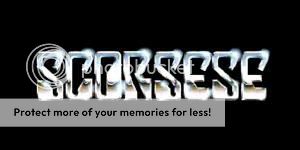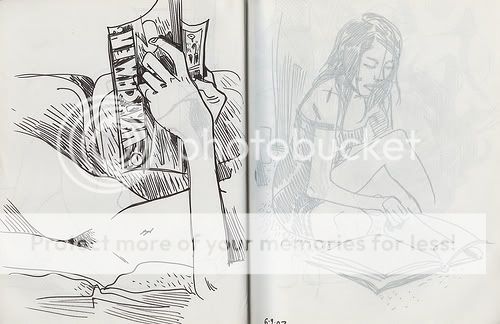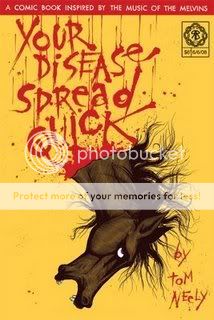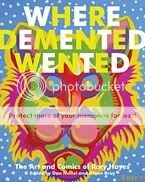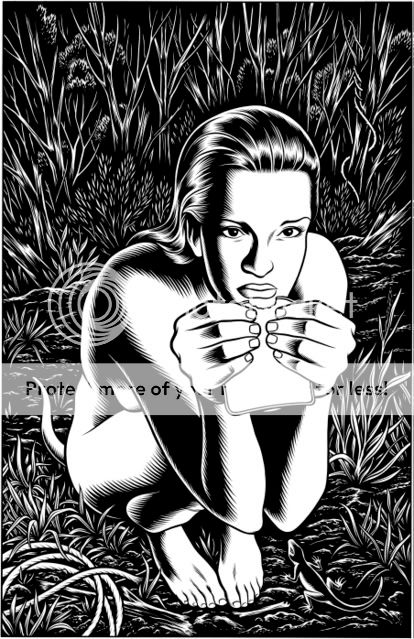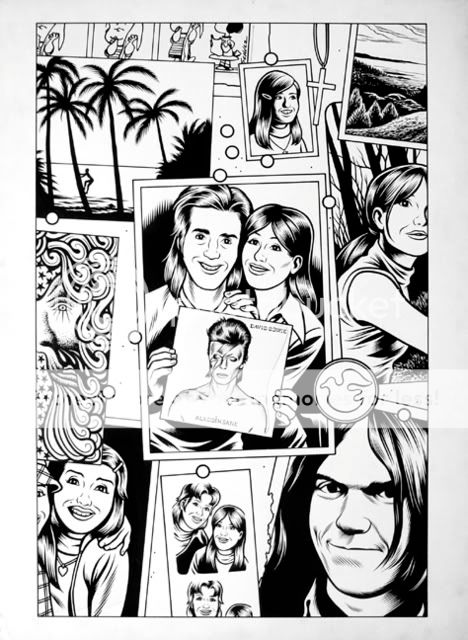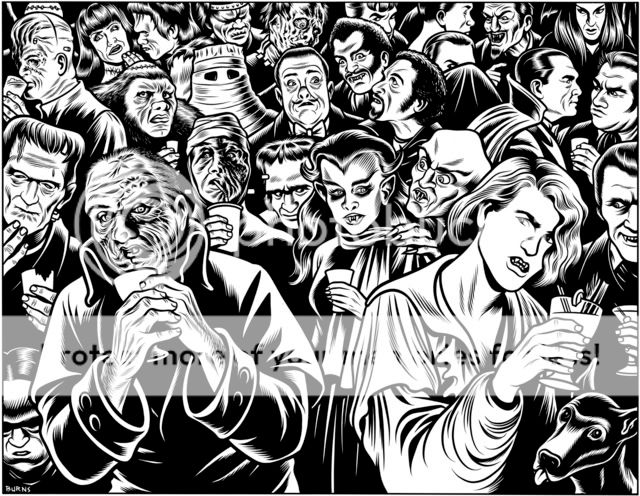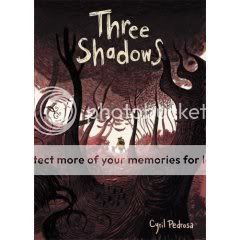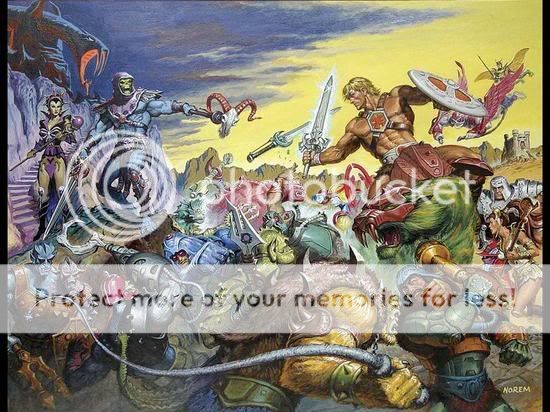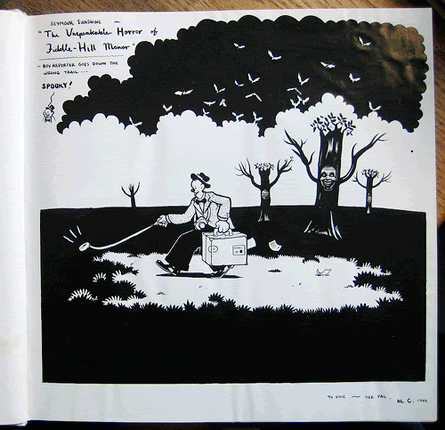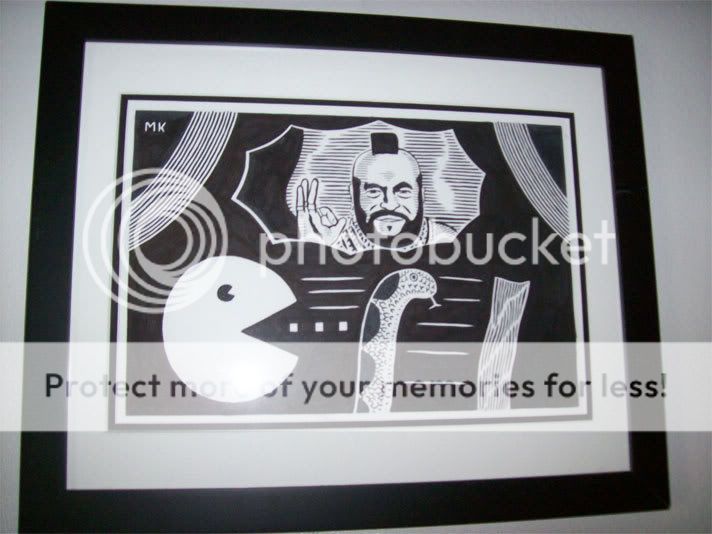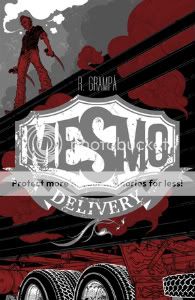The time of Art Out of Time
Since Tom mentioned it: I realized the other day that Dan Nadel’s Art Out of Time anthology of idiosyncratic comics might be the most influential book of the latter half of this decade*. Since it came out, we’ve seen the release or impending release of collections of Fletcher Hanks (two! the first of which was a runaway hit and Eisner winner), Herbie, Rory Hayes, Ogden Whitney, Boody Rogers, additional early superhero stuff in Supermen!…all of these were featured in Art Out of Time and all of these projects have been rapturously received. That book spawned a cottage industry, and the way it’s reclaimed forgotten areas of comics’ past is unprecedented, at least as long as I’ve been paying attention to these things.
* First half: Kramers Ergot 4.
Comics Time: Brilliantly Ham-fisted
Brilliantly Ham-fisted
Tom Neely, writer/artist
I Will Destroy You, July 2008
20 pages
$5
They can’t all be winners, but this collection of “19 comic strip poems” originally published on Tom Neely’s blog boasts some very strong work, including among them some of my favorite comics of the year. Constructed by juxtaposing a simple sentence against a four-panel strip’s worth of largely abstract imagery, these comics are a veritable catalogue of Neely’s visual preoccupations: Tall houses with crooked chimneys, Gottfredson-style white gloves, deep-black, viscous blots of ink, lone trees, holes, the severing of heads or hands. At times they’re used to strike a harrowing tone of confusion and despair–“Seething Rage” is a memorable portrait of a literally beaten man, while “House of Cards” plays off one of my personal favorite tropes for utter senselessness, roadkill. Given my own predilections it’s probably no surprise that the book’s more hopeful moments–“New,” touting the power of hope in the form of a newborn; “R.R.I.P.”, a declaration of ars gratia artis inspired by painter Robert Rauschenberg–leave me cold, leaning a little further toward the mushiness that is an occupational hazard of “comic poetry.” Still, “O.K.,” a full-color strip that overwhelms with the beauty of its palm-trees-at-sunset vista while the text celebrates the acceptance of a proposal, proves that Neely has the illustrative chops to give even his most (understandably!) sentimental inclinations real punch.
Carnival of souls
* Tom Spurgeon interviews editor Sammy Harkham about his needlessly “controversial” giant-size anthology Kramers Ergot 7. Check out this creator line-up for pete’s sake!
Rick Altergott, Gabrielle Bell, Jonathan Bennett, Blanquet, Blex Bolex, Conrad Botes, Shary Boyle, Mat Brinkman, John Brodowski, Ivan Brunetti, C.F., Chris Cilla, Jacob Ciocci, Dan Clowes, Martin Cendreda, Joe Daly, Kim Deitch, Matt Furie, Tom Gauld, Leif Goldberg, Matt Groening, John Hankiewicz, Sammy Harkham, Eric Haven, David Heatley, Tim Hensley, Jaime Hernandez, Walt Holcombe, Kevin Huizenga, J. Bradley Johnson, Ben Jones, Ben Katchor, Ted May, Geoff McFetridge, Jesse McManus, James McShane, Jerry Moriarty, Anders Nilsen, John Pham, Pshaw, Aapo Rapi, Ron Rege Jr., Xavier Robel, Helge Reumann, Ruppert & Mulot, Johnny Ryan, Richard Sala, Souther Salazar, Frank Santoro, Seth, Shoboshobo, Josh Simmons, Anna Sommer, Will Sweeney, Matthew Thurber, Adrian Tomine, C. Tyler, Chris Ware, and Dan Zettwoch.
Stupid Publisher Tricks: Too Many Awesome Anthology Contributors
* Speaking of absurdly stuffed packages of comicsy delights, Grant Morrison has a lengthy interview up with IGN’s Dan Phillips, and it’s as good as you’ve come to expect from the guy. It’s more or less equally split between Morrison’s trademark close reading of superhero tropes and metacommentary on the making of a modern superhero story, but I thought there were a couple of points particularly worth pointing out. First, here’s a bone that many hardcore DC fans will be glad to have been thrown:
IGN Comics: I don’t want to spend too much time on this topic, because you’ve addressed it elsewhere, but there have obviously been some discrepancies between parts of FinalCcrisis – mainly, the death of Orion – and Countdown and Death of the New Gods. At what point did you realize this would become an issue, and do you think it will affect any other aspects of your story?
Morrison: There were a couple of discrepancies which affected the early issues of Final Crisis and which came about because of the way the two books were being written out of order and to different deadlines.
Ultimately, it comes down to me as the last guy in the chain to fix it all, which is what I’m going to do. I’m actually going to make all the discrepancies work and tie in, and I’ve got a plan to fix it. To me, it was just like, “Oh guys, don’t worry about it.” Sometimes human error just creeps into the system. But I also realize that a lot of readers have a genuine emotional investment in the strict coherence of these patchwork fictional universes, so it seemed only fair that I should use the Crisis to clean up any lingering problems.
IGN Comics: That’s interesting, because Crises have always sort of been used to clean up continuity problems.
Morrison: Yeah, they always did that sort of thing with Crises, didn’t they? And I didn’t want to make this any kind of continuity reboot, which it’s not. But I did realize, well, why not set time and space right ? I can easily provide a reason for why things played out differently in different books.
That soon leads into this:
Remember also that, despite my inexplicable reputation among certain fans as a ‘difficult’ writer, I’m actually one of the most successful people in the comics business and have been for a long time. I wrote what’s still the highest-selling original graphic novel ever, I wrote DC’s biggest selling book for years with JLA, I wrote Marvel’s most popular X-title.
It is easy to forget that for all of Morrison’s well-deserved rep as being one of superherodom’s most idiosyncratic and artful writers, his stories tend to be rigorously titled to whatever he sees as being the demands of the zeitgeist. His lengthy pitches almost always include an explanation of why his ideas, besides being strong on the merits, will sell like the Dickens. Anyway, the whole interview is juicy like this. Give yourself half an hour before Obama’s speech tonight and dig in. (Via Kevin Melrose.)
* WANT: CineFile Video’s auteur/metal mash-up T-shirts! (Via Keith Uhlich.) Drooooool…
* Matthew Perpetua salutes Trent Reznor and Nine Inch Nails for their…work ethic?
* On the “three great tastes that taste great together” front, Paul Pope draws a nude woman reading Watchmen.
* I’ve often thought that furries are an underserved demographic in the soft-drink market, haven’t you? (Via Andrew Sullivan.)
* Finally, Tom Spurgeon gives you a present in the form of this incredible gallery of art as we all wish a very happy 91st birthday to the late Jack Kirby, the King of Comics. Here is my favorite thing he ever drew.
Public Enemy – “Fight the Power”
The first hip-hop song I ever loved, “Fight the Power” is arguably the greatest hip-hop song ever, but part of me thinks Spike Lee’s video for it is even better. Every time I see it I find myself astonished that such a thing ever even happened, let alone was filmed. The most powerful aspect of its rally format is exactly what people are rallying around. With the exception of the song’s title there is literally no sloganeering to be found on any of the signs and placards–each is simply emblazoned with a proper noun or a person’s photograph, as though merely asserting the presence of “BROOKLYN,” “FLAVOR FLAV,” or Malcolm X is enough of a statement in and of itself, which at the time it was. It’s what I’ve called an “image of triumph-through-simply-existing” and it wows me every time.
Comics Time: Your Disease Spread Quick
Your Disease Spread Quick
Tom Neely, writer/artist
characters and dialogue inspired by the album (A) Senile Animal by the Melvins
Robotic Boot, Summer 2008
22 pages
$6
You don’t need to listen to the Melvins to appreciate Your Disease Spread Work as further evidence, as if any were needed after The Blot, that Tom Neely is working the most fruitful vein of horror-slash-artcomics since Al Columbia. Like Columbia, Neely’s work borrows stylistic elements from masterful old black-and-white kids’ cartoonists like Otto Mesmer and Floyd Gottfredson, then harnesses it to a unique vocabulary of monstrousness and murder. While Columbia tends toward intimate horror in the work of his I’ve seen, Neely’s best stuff is characterized by a tendency to scale upward and outward at breakneck speed, with threats suddenly emerging as colossal if not outright apocalyptic.
YDSQ addresses that tendency head-on, beginning and ending with words of woe from a doomsday prophesier with the head of a horse. In between we encounter decapitations, an infernal saloon populated with infamous tyrants, Neely’s trademark black-ink blots, a sequence reminiscent of that old 7-Up mascot Spot crossed with H.P. Lovecraft, the Big Bad Wolf, a ghoul, a thunderbird, a Fritz Lang-style robot bride, a mummified Baby Herman type, scenes of everyday depravity, and more. At no point does any of this arrive from a predictable direction or feel anything less than profoundly discomfiting. It adds up to a portrait of great unease with the direction of society, coupled with a gallows humor about it all (there’s a Hostess ad parody on the back cover to cleanse the palate). What it has to do with the Melvins I may never know, but it works as both an ad for the band and a statement completely independent of them.
Carnival of souls
* You heard it here last: Warner Bros. is revamping the whole way it does the superhero-movie business, both by nuking Bryan Singer’s Superman Returns would-be franchise launch and starting the Man of Steel from scratch and by developing its multitude of characters with an eye toward bringing them together down the line in a Justice League movie rather than the other way around–in other words, doing it Marvel Studios/Avengers style. I think there are both good things and bad things about this news. “Good” includes the sense that they’re going to try to make a good movie out of Justice League rather than doing it on a comparative shoestring with a bunch of pretty nobodies. “Good” also includes scrapping Singer’s Superman Returns continuity, what with its bastard super-children and complete lack of punching. “Bad” is some dopey suit saying “We’re going to try to go dark to the extent that the characters allow it,” thus ignoring the lessons the past 20-plus years of superhero comics have taught us about the wisdom of going dark with everyone and acting like the success of superhero movies begins and ends with The Dark Knight (and Watchmen, one supposes) while ignoring Spider-Man, Iron Man and so forth. “Bad” is also the taste left in my mouth anytime I read Hollywood executives talking about how best to make millions of dollars off the hard work and creativity of people who have died and will die in relative penury.
* Speaking of execs in need of defenestration: Clive Barker tears Lionsgate head Joe Drake a new one over his mishandling–deliberate, Barker once again alleges–of Midnight Meat Train, which Barker says was buried a long with several other films in order to keep the spotlight on the Drake-shepherded genre effort The Strangers. (Via Dread Central.)
* Quote of the day:
Vertigo’s typically indifferent colors don’t help, of course: strap in for the color brown, everybody! Do they get a discount on brown? Is that how they keep the costs down? Seriously, dead seriously: What is with these people, and the color brown? Does anyone even know? This is an open invitation to any Vertigo colorist willing to do an interview about the color brown. Please explain.
—Abhay Khosla, in a review of Air that’s ever so slightly less unreadably schticky than normal. This has long been a point of bafflement with me, too.
* Joe McCulloch reviews the inaugural entry in Rick Geary’s Treasury of XXth Century Murder, The Lindbergh Child. How kickass would a Treasury of Victorian Murder Omnibus be?
* I’ve had two dreams about the lost fourth season of Deadwood in the past week. They’ve been violent and awesome.
* I enjoy many current superhero comics by several different superhero comics creators, some of which are good, some of which are very good, some of which are even great, but it occurred to me the other day that really the only guy working at a level comparable to the best or even the very very good alternative comics creators right now is Grant Morrison, and when I read writing that fails to keep this sort of thing in perspective by treating random aspects of current superhero culture like it’s the most important and innovative and forward-looking comics material on Earth, I get very irritated.
* Finally, congratulations to Rick Marshall on his new gig as co-editor of MTV’s Splash Page comics/movie blog!
Comics Time: Incanto
Incanto
Frank Santoro, writer/artist
PictureBox Inc., 2006
44 pages
$5
I have no idea if this is an active reference point for him at all, but I can’t read Frank Santoro comics without thinking of the swirly, sensual, romantic rapture of a good shoegaze song. Both are (generally) more concerned with mood than with any kind of narrative–knowing, perhaps, that emotions can be stories in and of themselves. This particular comic reads a little like a dress rehearsal for the more rhapsodic moments of Santoro and Ben Jones’s teenage-riot series-cum-OGN Cold Heat. Joining his usual minimal line to an equally minimal layout (one or two panels per page), complemented by unbroken fields of blue, orange, and white color, Santoro “tells” the “story” of an emotionally epic romance in the language of metaphor–wild horses, mysterious combat, vampiric antagonists, deserts and mountains, blazing suns, parents that just don’t understand, desperate embraces, taking off a shirt, hands on bodies. Each of these sort of dissolves into the next in a fashion that enables you to make it all the way through the comic in under a minute, or flip back and forth and re-re-re-read like putting “Vapor Trail” on repeat. It’s slight, and not for everyone, but lovely for me. I want to connect with the emotions he’s conveying even though feeling them has become a distant memory for me.
Comics Time: Where Demented Wented: The Art and Comics of Rory Hayes
Where Demented Wented: The Art and Comics of Rory Hayes
Rory Hayes, writer/artist
Dan Nadel and Glenn Bray, editors
Fantagraphics, August 2008
144 pages
$22.99
I do a lot of reading on a crowded Long Island Rail Road train into and out of New York City. Since I am still a polite, people-pleasing elementary school kid at heart, this made it impossible for me to sit back and enjoy the section of this book that reproduced Cunt Comics #1, you know? So what I ended up doing is skipping that stuff and reading everything else, saving the Cunt material for a time when it wouldn’t be inflicted on unsuspecting commuters. Stripped of that almost indescribably vulgar middle section, the work of the live-fast-die-young underground comix legend Rory Hayes as collected in Where Demented Wented comes across less like that of a knowing, Crumb-style provocateur–or a novelty-act modern primitive, for that matter–and more like that of a wild-eyed innocent who’s seen far too much. I guarantee you I’m the only person who’s going to make this comparison, but do you remember the scene from Stephen King’s science-fiction short story “The Jaunt” where (SPOILER WARNING FOR ANYONE WHO FALLS INTO THE PART OF THE VENN DIAGRAM WHERE “RORY HAYES READERS” AND “READERS INTERESTED IN THE SHORT STORIES OF STEPHEN KING BUT WHO HAVEN’T YET READ THEM” OVERLAP) the kid holds his breath when they dose him with anesthetic prior to teleportation, so he comes through the other side having been driven bugfuck insane by the infinity of time and space his mind experienced during his instantaneous travels? Sort of like that.
It doesn’t necessarily start that way. In the first, comparatively crudely drawn stories from Hayes’s Bogeyman Comics #1, Hayes crafts surprisingly deft and tightly paced homages to the macabre twist-ending horror stories of EC Comics. In addition to those ’50s classics, Hayes’s emphasis on decay recalls the weird work of Lovecraft and Bierce, while his inventive staging and attention to environment anticipates work by far more surface-sophisticated genre artists, from Josh Simmons’s House and Jessica Farm to Clive Barker’s “The Midnight Meat Train.” While the mood here is certainly one of impending doom, it is at least a doom that suggests through contrast the possibility of making it out alive. I can’t decide whether Hayes’s trademark teddy-bear protagonists–whose incongruity and iconicity serve to instantaneously (and rather amusingly) anchor even his most outlandish and savage stories to a dimly remembered time of childhood playfulness–make things seem more hopeful (innocence exists!) or less (innocence is destroyed!).
It seems as though when Hayes’s drug use became dominant enough to start finding its way into his work on an explicit level shortly thereafter, however, a switch flipped. Skip past the Cunt Comics interregnum as I did and all of a sudden you find a Hayes whose work is far more artistically refined–with an almost Drew Friedman-slick stippling effect at times–while his conceptual framework has expanded outward almost infinitely, to far more threatening effect. In between cynical semi-autobiographical accounts of tweaked-out excess and gross-out humor-ish strips with a bitter Country Joe “Whoopee! We’re all gonna die!” tone, Hayes’s protagonists are now more at risk from contact with eternity or the destruction of the entire world than they are from creatures locked behind cellar doors. Perhaps the most memorable of these later strips involves one of the teddy bears traveling to a dead world filled with abandoned towers and forgotten artifacts, its sole surviving inhabitant scrawling the enigmatic, haunting phrase “WE TRIED” on the ground, reducing the doomed explorer to tears. Seen in the light of material this powerful, Cunt‘s onslaught of castration, bodily fluids, and vaginas drawn as though the artist had hardly even a passing familiarity with the form seems like a necessary mental enema, a way of throwing off almost any kind of restraint self or society could impose so as to better access the frightening truth, if that’s what it is.
Towards the end of the book, during an essay of remembrance written by Rory’s brother Geoffrey, a short, early comic by Rory called “Lost at Sea” is discussed and reprinted at a reduced size. Based on an 8mm film Rory made, it features a teddy bear in a tiny boat, adrift in an enormous and storm-tossed sea. Finally, after a particularly frightening tempest, the bear finds himself and his boat safe on the sandy shore. The final image is simply of the bear’s footprints, leading away from the water back home. In a way, this collection is that trail of footprints.
Carnival of souls
* First up, some Sean T. Collins In The News updates. I have a piece on Roberto Aguirre-Sacasa and Mike Perkins’s Marvel Comics adaptation of Stephen King’s The Stand in the new issue of Maxim, the one with Anna Kournikova on the cover. The stuff I’ve done for this magazine is by far the stuff that my family members and the friends and co-workers thereof are most likely to notice.
* Over at Marvel.com, for whom I’m the official Stand correspondent, I have a short piece on the character of Randall Flagg and his appearances throughout the King-verse.
* Meanwhile, there’s a shout-out for my comics anthology Murder in the latest issue of ToyFare, to which I remain a regular contributor. They liked it, and before you say “well, that’s because you work for them,” remember they could just as easily reacted with complete disgust and slowly phased me out of my freelance work over there. Why not follow their suggestion, then, and buy a copy for yourself?
* I’m told a couple more of my one-liners showed up in the crawl at the bottom of the video pieces over at the Onion News Network. So if you enjoyed gags about the military deploying killer robots in “Operation What Could Possibly Go Wrong” or the discovery that Taco Bell Express is just a regular-speed Taco Bell with fewer seats and menu items, you know who to thank.
* Feast your eyes on this awe-inspiring gallery of Charles Burns art, from a show at the Adam Baumgold Gallery in NYC that will run from September 5th to October 12th. (Via Heidi MacDonald.)
* Frank Santoro reviews Joan Reidy and Ron Rege Jr.’s classic teen-sex comic Boys. That the new Rege odds’n’sodds collection from Drawn & Quarterly, Against Pain, may give these strips the audience they deserve is really a joy to me.
* Chris Pitzer, founder of the high-quality comics and art-book publisher AdHouse, recalls his life in comics, one store at a time. It’s a unique and revealing rubric for this kind of trip down memory lane.
* Like Matthias Wievel, I too have found it strange that the superheroes in Secret Invasion all seem pretty okay with killing every Skrull they can get their hands on. I know the idea is that it’s a war, and that’s fine, it actually makes more sense that they’d act this way than how these things are normally depicted, but you’d think that maybe they’d have taken some casualties on their own side before launching straight for the jugular simply given the traditional superhero discomfort with lethal sanction. What’s weird is that I don’t guess that this was ever even a point of discussion among the creative team. (Via Tom Spurgeon.)
* Courtesy of Rob Bricken at Topless Robot comes one of the strangest, most delightful things I’ve come across in quite a while: ELA. A wondrous mix of live action and crude digital animation, it seems to be an all-in-one homage to She-Ra, He-Man, Heavy Metal, Space Invaders, Tron, The Neverending Story, Monty Python, classic arcade games, the Italian and American B-movie fantasies of the ’70s and ’80s…but not in the same way that Doomsday riffs on that era’s action, horror, and post-apocalyptic sci-fi films. There’s something more, I don’t know, poetic in nature about what this little film does with its constituent parts, where the emphasis isn’t on eliciting “hey, that was awesome!” recognition with various bits of action but on conjuring a similar sense of wonder, glamour, spectacle, danger, excitement, occasionally eroticism, and all-pervasive weirdness to that which these rough-around-the-edges entertainments provided due to their own magpie nature and make-it-up-as-you-go-along approach to genre. It’s undeniably trippy and “arty,” but it doesn’t deny the simple pleasure of imaginary landscapes or epic sountrack-synth-rock or a woman with a lovely tush. And the ending is bracingly unpleasant. In comics terms it’d be part Powr Mastrs, part Scott Pilgrim, part Goddess of War. Take a look:
Carnival of souls
* Good news: Lord of the Rings screenwriters Peter Jackson, Fran Walsh, and Philippa Boyens will be writing The Hobbit and its sequel/parallel/whatever “Film 2.” Bad news: Guillermo Del Toro is still directing them.
* Joe McCulloch reviews Mome Vol. 12–fortified with vitamins (David) B and K(illoffer).
* You can buy that Scott Pilgrim Colour Special online now.
* The final season of Battlestar Galactica will be preceded by webisodes. (Via Jason Adams.)
* If you’re up for hearing about a bunch of new characters who’ll be showing up on Lost next season, you can click here and here. I’m gonna try staying spoiler-free for now. (Via The Tail Section.)
* Some people are saying nice things about my writing, which I appreciate. Here’s Marc-Oliver Frisch and here’s The Inkwell Blog.
* Finally (via Topless Robot), this is horrible and hilarious: the final terrifying moments in the life of a Goomba.
Comics Time: Invincible Iron Man #1-4
Invincible Iron Man #1-4
Matt Fraction, writer
Salvador Larroca, artist
Marvel, May-August 2008
32 pages each
$2.99 each
The problem with Iron Man in the wildly popular, not good Marvel event series Civil War wasn’t that he was wrong, but simply that he was written wrong. You may recall that the conflict between Iron Man and Captain America was driven by Iron Man’s desire to see all superheroes register with the government, an eminently sensible approach to human weapons of mass destruction no more outlandish than requiring official sanction for police departments and the Marines (or hell, student drivers and barbers). Unfortunately, it fell to the character to bear the metaphorical weight of warantless wiretapping, the abolition of habeas corpus, secret prisons, torture, and all the other actual excesses of the War on Terror. And so the writers of the event, particularly the main series’ Mark Millar and Amazing Spider-Man‘s J. Michael Straczynski, turned the character into an unlikeable, smarmy fascist bastard.
You’ll hear some people say this is perfectly appropriate for a character whose secret(ish) identity was a munitions expert who built his first suit of armor in order to kill his way out of an NVA prison–that he’s the military-industrial complex personified. Me? While I read Civil War in disbelief I was listening to Ghostface Killah’s Supreme Clientele and thinking “there’s another way, dammit!” The most consistently enjoyable member of the Wu-Tang Clan, you see, adopted the alternate personality of “Tony Starks,” basically the smoothest operator ever–going so far as to call his solo debut Ironman and lace Supreme Clientele with samples from the old Iron Man cartoon (including the “cool exec with the heart of steel” bit from the theme song). For Ghostface, it’s not Stark’s armor that makes him invincible, but his raw swagger and hustle, qualities that beat the shit out of having his defining characteristic be proclaiming “I’m a futurist,” then sending jackbooted SHIELD troops to rough up your friendly neighborhood Spider-Man. As for his war-profiteer aspects, I can’t imagine they’re any harder to get away from than, say, the entire Silver Age has been for most heroes. In short, if your Iron Man comic was not made in the spirit of “Nutmeg” or “Apollo Kids,” you failed.
From the moment I heard that Ghostface had a cameo in Jon Favreau’s Robert Downey Jr.-starring Iron Man film I had a hunch that the filmmakers “got it,” and sure enough, they did. The movie showed it was possible to tell the story of a cocky boozed-swilling genius weapons manufacturer-slash-renowned cocksman who dresses up in armor and blows things up and have him be cool and fun. Imagine that! The whole thing was a vindication and I very much hoped that the writers and editors responsible for the character’s direction in the comics over the past few years were roundly shamed.
Matt Fraction’s Invincible Iron Man was clearly created with the same remit as the movie in mind, and so far it succeeds. It does so in large part by simply choosing to ignore elements that get in the way. Character-wise, Fraction jettisons both Iron Man’s recent-vintage neoconservative-bugbear characterization and former writer Warren Ellis’s Web 2.0-triumphalist technophilia. It’s impossible to gloss over the fact that Stark is now Director of SHIELD and therefore Big Brother for the world, but that’s dealt with minimally here, essentially just providing him with another set of toys to play with.
Plotwise the story could, with minimal tweaking, be a direct sequel to the movie, pitting Stark against the nutbag son of his vanquished rival Obadiah Stane. The younger Stane, Ezekiel, is entertainingly sociopathic in the literal sense–a callously murderous guy who’s seemingly incapable of experiencing empathy. The clever bit is giving him these personality traits in the same way your average douchebag Real World contestant has them–making him a sleazy “moral moron” who, instead of cheating on his girlfriend and drinking to violent, misogynistic excess, blows up buildings full of people. Other cinematic strands are also picked up, particularly Stark’s chemistry with his girl friday Pepper Potts. A running subplot in which Stark saves her from wounds incurred during a suicide bombing by implanting one of those magnetic-disc things in her chest and then teaching her how to use it to fly is an intelligent way to keep that wonderfully weird, oddly romantic, freakily Freudian scene from the movie where Gwyneth Paltrow sticks her hand in Downey’s gooey open wound in mind throughout the story’s duration.
Now, it’s not a great comic–some of the nods in the direction of Iron Man As Supercool Cool Guy, like a bit involving a bevy of babes in issue #1, feel a bit pro forma, and nothing we’ve seen so far is wild and transcendent and unpredictable like the best superhero stories, the ones that stick with you, tend to be. (Ones like Fraction’s collaboration with Ed Brubaker, The Immortal Iron Fist, with which Invincible Iron Man has in common a billionaire-crimefighter protagonist and an adjectivally alliterative title.) Larocca’s work is slick and candy coated and avoids his distracting habit of photo-referenced stunt-casting (except for a scene in issue #4 where Stark slips some Iron Man tech onto the black market by giving it to Danny DeVito and Paris Hilton); it’s kind of perfect for the project, but limited in its affect. Zeke Stane lacks the memorable visual design that makes any great villain click. But in terms of making the Iron Man concept readable again. and offering a version of the character who wouldn’t make people who enjoyed his film incarnation run screaming in the opposite direction, so far so good.
Gary Glitter – “Do You Wanna Touch Me (Oh Yeah)”
So I read today that wildly entertaining, shamelessly pandering bubble-glam musician and child-molesting creep Gary Glitter was released from prison in Vietnam today. (Via Whitney Matheson.) I have a hard time expressing how difficult it is for me to deal with Gaz being a predatory bastard because his music, and this song in particular, played a big role in me becoming the person I am–not as big as Bowie or Roxy or Iggy or Eno, certainly, but more than any of the other bubbleglam people. I just think there’s something really…accurate about the way the lyrics of this song intertwine with that relentless, often-imitated beat-clap and that fat, vaguely sinister guitar noise to verbally and musically convey HORNY in all-caps. Like, when you’ve felt that way, isn’t this the way you felt? But the best part is the end, when the Glitter Band shifts the notes around atop the main riff–like that, it goes from desperate to confident, from “oh god I hope it happens I need it to happen please please please” to “oh god it’s gonna happen it’s happening yes yes yes!”
Carnival of souls
* Please stop reading this entry and immediately click over to film scholar David Bordwell’s analysis of the modern superhero-movie trend. It is so full of insight I hardly know where to begin quoting, but it was one of those rare pieces of analysis that actually made me laugh out loud at one point:
The blogosphere is already ablaze with discussions of whether the film supports or criticizes Bush’s White House. And the Editorial Board of the good, gray Times has noticed:
It does not take a lot of imagination to see the new Batman movie that is setting box office records, The Dark Knight, as something of a commentary on the war on terror.
You said it! Takes no imagination at all.
But it’s not simply an exercise in kicking around the Dana Stevens/Wall Street Journal “genre film as current events report” school of thought. It’s just a masterful look at everything from the changing nature of the star system and what constitutes “good acting” to advances in special effects to the rise and fall of disreputable genres to the relationship between superhero films and the comics from which they are adapted to the shortcomings of Christopher Nolan’s use of cinematography and editing and on and on and on, with insightful criticism of Iron Man, The Dark Knight and many other specific films besides. If you read one article about superhero movies this year, make it this one.
* Meanwhile, if you avoid one ill-informed, aesthetically barren post and comment thread about art comics, make it this one about Kramers Ergot 7. I’m with Chris Butcher on this one, man. How is this even a topic for heated debate in the first place? 1) Page count is deceiving when you consider both the size of the pages (16″ x 21″!) and the quality of the many, many, many contributors 2) It’s priced comparably to big art books 3) I can’t imagine an outfit like Buenaventura Press trying to rook people 4) if you can’t afford it, don’t buy it–the end!
* They’re going to remake Poltergeist. Maybe they’ll shake things up by making this one a good movie, though that will no doubt upset fans who demand that the remake remain true to the original. (Via Bloody Disgusting.)
* Bruce Baugh discusses of how he values the formation and maintenance of communities based on shared values in RPGs. It reminds me a lot of how appealing I find fiction in which the characters privilege cooperation, competence, and creativity.
* Ryuhei Kitamura briefly talks to Bloody Disgusting about Midnight Meat Train, his adaptation of the short story of the same name by his fellow Brotherhood of the Patchwork Pants member Clive Barker.
* In other other adaptation news, Sam Raimi and Tom Cruise will be teaming up to adapt Ed Brubaker and Sean Philips’s excellent superhero/espionage thriller Sleeper. Cruise would actually be good in this.
* Finally, (via Whitney Matheson) nooooooooooooooo
Comics Time: Three Shadows
Three Shadows
Cyril Pedrosa, writer/artist
First Second, April 2008
268 pages
$15.95
An admirable lack of ambition characterizes this impressive work of fantasy from European Disney-animator-turned-graphic-novelist Cyril Pedrosa. He’s not interested in building a sprawling, intricately ordered alternate world, he’s not aiming to wow us with the scope of his imagination, he’s not serving up a Hero, he’s not attempting to harness his childhood fantasies into coherence. He’s simply, loosely using the genre to tell a story about fear and pain. One of the best aspects of that story is how his surface-beautiful line–a miraculously curvy, ropy thing he can refine or sketchify on cue–never overwhelms with its loveliness the aspects of the plot that count on horror. On the contrary, somehow, seeing the titular entities as they loom like a cross between the Ringwraiths and the Shining sisters on a faraway hill for the first time, and seeing the reaction of the loving nuclear family at the heart of the story to them, are made creepier and more disconcerting by their lush surroundings. Similarly, each time the story does branch out in a more expansive direction (usually, but with one major exception, brought about by the family’s travels), the lack of preexisting expository world-building makes the world seem more mysterious and immense with each new glimpse of a new environment. Ultimately this is a story about the mortality of children in the face of a capriciously cruel world, and the crazed despair this can bring on in their parents. It’s a bitter topic, and makes for one of those rare cases where the adjective “bittersweet” is truly applicable.
Carnival of souls
* Dick Hyacinth wasn’t a big fan of Grant Morrison’s most direct precursor to Final Crisis, JLA: Rock of Ages.
* So far, Quentin Tarantino’s World War II actioner Inglorious Bastards stars Brad Pitt, Eli Roth, and Mike Myers. That’s really weird. (Via AICN.)
* Maybe they’re remaking Candyman, maybe not. Either way I am really, really skeptical that the “they’re making him a white guy” angle has any basis in reality.
* They are remaking The Rocky Horror Picture Show, and neither Richard “Riff Raff” O’Brien nor Barry “Asshole” Bostwick are crazy about the idea. Bostwick goes after Shock Treatment and the just-plain Rocky Horror Show while he’s at it. (Via Bloody Disgusting and Whitney Matheson respectively.
* Russia’s military adventure in Georgia put me in mind of the USSR’s conduct in Watchmen pretty quickly given that I’d just finished re-reading the book when the fighting broke out, but it took this facetious Matt Yglesias post wondering if Warner Bros. was somehow behind the hostilities to make me realize that if the current climate of Cold Warmongering among America’s conservatives keeps up, Zack Snyder’s movie version of Watchmen might be interpreted as anti-Russian propaganda just as his 300 was viewed as anti-Iran.
* I can’t decide how I feel about He-Man screenwriter Justin Marks’s contention that any movie version of the beloved-by-me action-figure franchise needs to persuasively explain where its cockamamie mix of science-fiction and fantasy originated in a world-building sense. One the one hand it seems really silly to worry about realism with characters like Ram-Man and Stinkor. On the other hand, trying to construct a believable rationale for such characters might be even wilder and weirder and more wonderful than just leaving them alone. (Via Topless Robot, who also post this awesome painting.)
Comics Time: The League of Extraordinary Gentlemen: Black Dossier
The League of Extraordinary Gentlemen: Black Dossier
Alan Moore, writer
Kevin O’Neill, artist
DC/WildStorm/America’s Best Comics, 2007
208 pages, hardcover
$29.99
It occurred to me when reading this latest installment of Moore and O’Neill’s journey through the literature of the fantastic that it’s basically Moore’s version of Earth X. Like that Jim Krueger/Alex Ross exercise in continuity farming, Moore’s overarching narrative scheme is to find a way to connect nearly every character in the history of genre storytelling, from Jehovah to James Bond.
This volume goes further than ever in that direction, revealing that all of the world’s extraordinary gentlemen, supernatural creatures, and so one can trace their origin back to two warring (and occasionally miscegenating) tribes of godlike beings: the Bible’s “Elohim,” which either directly or through their offspring account for the Judeo-Christian God, his ancient pagan counterparts, and the pantheons of Greece, Egypt, and Germany/Scandinavia; and (basically) Lovecraft’s Great Old Ones, whose descendants include pretty much every monster known to man.
The “good” gods have made two notable attempts to bridge the gap between mortal and deity. The first was the Greek Age of Heroes, an experiment in interbreeding that the Gods aborted at Troy when it became apparent that these powerful people were pretty much all sociopathic killing machines. The second, as it turns out, was the creation of the original League of Extraordinary Gentlemen in Shakespeare’s time; here, the Elizabethan Age has been recast as the reign of Gloriana, England’s Fairie Queen, whose assemblage of folks like Prospero and Orlando to “guard the Realm” was really just a cover for forming a group that could successfully liaise between the natural and supernatural worlds. (At least I’m pretty sure that’s the gist.) Meanwhile your friend and mine Cthulhu and his chums keep trying to pop in and devour our souls, the prevention of which – along with thwarting mad scientists, guarding against invasions by rival species, and fucking – has been one of the various Leagues’ primary occupations ever since.
All of this information is contained in the titular dossier. The story takes place in the 1950s, where Mina Murray and Allan Quartermain are harried by elements of the rump Party dictatorship (yep, from 1984, though here the regime doesn’t seem to have lasted much longer than 1954) as they attempt to transport this stolen file to a person or persons unknown for reasons unknown. Both the prime mover and his motive turn out to be McGuffins of a sort, though; the main trick of the story is that all this business of constructing a Grand Unifying Theory of Genre Lit is presented in a series of pointedly dis-unified comics and prose pastiches, including faux-Shakespeare, a Beat novel by Sal Paradyse, a Tijuana Bible, a Jeeves vs. Cthulhu story (maybe my favorite), Crowleyana, boys’ adventure comics, and so on. I think it’s one of Moore’s cleverest conceits in ages, and gives O’Neill, letterer Todd Klein at all a chance to go absolutely buckwild. It’s fourth-wall-breaking fun.
It’s also completely impenetrable from time to time unless you come in with the requisite encyclopedic knowledge of Moore’s sources. I’m not saying that it’s impossible to get anything out of the book without recognizing every last reference – the moral of the story, and the reason why our heroes are cool and their enemies are bogus, are all quite clear whether you know who Raffles the Gentleman Thief is or not. But Moore is having just as much fun making connections, hiding Easter Eggs, and crafting hardcore continuity porn as any superhero writer, just with a different set of toys, and it’d be foolish to deny that. I did pretty well anytime Yog Sothoth or Conan or Dr. Caligari were on the scene, but at other times I could literally go for pages without catching a single reference. I don’t even necessarily think that Moore should care about this, since I doubt there’s anyone who did catch every reference whose name doesn’t rhyme with “Schmalan Schmoore” and he’s writing this story for maximum mind-blowage rather than optimal legibility. Moreover, the stuff that I got was an absolute hoot, and since I don’t believe that continuity-based storytelling is automatically shallow, I’m not going to make that argument any more here than I would when discussing The Sinestro Corps War. I suppose my point is that the two are more similar than you might think, and that maybe it’s that that makes LoEG books as entertaining as they are, and let’s be up front about it.
Carnival of souls
* Battling Blockbusters: Graeme McMillan and Matthew Perpetua & I discuss problems with Brian Michael Bendis’s Secret Invasion, while Matthew and Joe McCulloch discuss impressive aspects of Grant Morrison’s “Batman: R.I.P.”
* Matthew also flags something I talked to him about regarding Watchmen that I neglected to put in my recent review of the book: Dave Gibbons’s portrayal of Laurie Juspeczyk. Basically, Gibbons draws Laurie as attractive but not a knockout (aside from what I think we’re supposed to see as a pretty slammin’ body). The way she looks and the way the guy heroes interact with her remind me of the hottest girl in your school or office or subculture. She may not have anything over some famous sexy movie-star person, but there’s something in the way she wears that Ministry T-shirt or sips her coffee during meetings, you know? You sort of see this play out in the way Dan Dreiberg reacts when he sees Laurie changing into her Silk Spectre costume. It’s not one of those movie-style “everything stops as the camera slowly pans up her body from toe to head and the guy stands there slackjawed” deals–it’s more like that mix of awkwardness and eroticism, that sudden and unexpected intimacy, when you see a woman you know and normally see fully clothed in a revealing bathing suit or underwear. It’s another of Gibbons’s great contributions to the book.
* While we’re on the subject, I don’t have much to say about the following thought beyond simply articulating it, but the way Rorschach and his “crimefighting” jaunts are portrayed are not unlike the masked killers of then-contemporary slasher movies, are they? His blank-slate mask wouldn’t look out of place alongside Michael Myers’s and Jason Voorhees’s.
* Speaking of Grant Morrison (we were, a few items ago), I don’t get the mentality that says ignoring bad comics makes your comic bad.
* It sounds like they’re not exactly shooting for the moon with that Rocky Horror Picture Show remake. (Via Bloody Disgusting.)
* The latest on nine inch nails’ dystopian multimedia project Year Zero is that Trent Reznor has pitched HBO on a two-season “maxiseries” adaptation, which he says was received enthusiastically, and that he’s still alluding to a second album based on the concept. (Via Pitchfork.)
* Wow, look at this Al Columbia “sketch” in Eric Reynolds’s sketchbook.
* This installment of Brian Ralph’s post-apocalyptic first-person thriller Daybreak may be the creepiest yet.
* Would you like to know the story behind this Michael Kupperman image?
* My between-jobs friend Rick Marshall is holding an eBay comics sale fiesta. Go check it out and see if there’s anything you’d like.
* Not a lot of horror news at the moment, but here in the real world there’s never any shortage of horror stories, from the Vince Weiguang Li Greyhound bus decapitation/cannibalism case I never got around to blogging about to the videotaped sexual torture and murder of a young boy in front of his sister by pedophile Joseph Edward Duncan III to the roach-covered, rotting, noxious trailer where Daniel Thurmond kept his wife and four children imprisoned for years.
* Happier note: Courtesy of The Peanuts FAQ (via Jonathan Bennett), I give you the complete text of Snoopy’s It Was a Dark and Stormy Night:
It Was A Dark And Stormy Night
by Snoopy
Part I
It was a dark and stormy night. Suddenly, a shot rang out!
A door slammed. The maid screamed.
Suddenly, a pirate ship appeared on the horizon!
While millions of people were starving, the king lived in
luxury. Meanwhile, on a small farm in Kansas, a boy was
growing up.
Part II
A light snow was falling, and the little girl with the
tattered shawl had not sold a violet all day.
At that very moment, a young intern at City Hospital
was making an important discovery. The mysterious patient
in Room 213 had finally awakened. She moaned softly.
Could it be that she was the sister of the boy in Kansas
who loved the girl with the tattered shawl who was the
daughter of the maid who had escaped from the pirates?
The intern frowned.
“Stampede!” the foreman shouted, and forty thousand
head of cattle thundered down on the tiny camp. The two
men rolled on the ground grappling beneath the murderous
hooves. A left and a right. A left. Another left and right.
An uppercut to the jaw. The fight was over. And so the
ranch was saved.
The young intern sat by himself in one corner of the
coffee shop. he had learned about medicine, but more
importantly, he had learned something about life.
THE END
* Finally, I loved you, little tyke.
Comics Time: Mesmo Delivery
Mesmo Delivery
Rafael Grampa, writer/artist
AdHouse, 2008
60 pages
$12.50
Normally saying something like “his art is varyingly reminiscent of Geof Darrow, Al Columbia, John Kricfalusi, and Dave Cooper” would be hyperbolic to the point of absurdity or even insanity, but hoo boy, Rafael Grampa. Visually he may be the most accomplished new cartoonist of the past two or three years. Best of all, he’s no slouch as a storyteller, either. I don’t mean in terms of legibility, because there are plenty of talented illustrators whose beautiful comics are easy to follow. I mean in terms of having a story worth telling, a spectacle but not an empty spectacle. On the surface it’s just a gorgeous, ultraviolent fight comic, the kind of thing you see plenty of anymore, but it’s different. For one thing, it’s creepy and uncomfortable, as much so as the similar opening sequence in Natural Born Killers. It’s as raw and blackly humorous and confrontational, and at times edgily sexual, a work of gore as Darrow and Frank Miller’s Hard Boiled. It subverts expecations, creating a “hey look at that big guy, I bet he’s usually pretty calm until you rile him at which point he’s invincible and badass” brick-type figure and then flipping your premature belief in his competence on its ear. It contains out-of-nowhere visual flourishes: A smartly laid-out “commercial break,” a slavering devil lurking underground like something out of a medieval engraving. The lettering–Rafa Coutinho gets this credit, though sometimes the words are so integral to a particular panel that it’s tough to see how someone other than Grampa did it–addresses music and whimpering with inventive, tactile flair. The colors, selected by Grampa and deployed by Marcus Penna, somehow take that green/brown Vertigo palette and makes it gooey rather than acidic. Everything looks dirty. The narrative flashes back unexpectedly and intelligently. The English-language dialogue, provided by Ivan Brandon, is tight. (“Be very discreet.” “When have I not been?” “No time I know of, but I’m in charge and if I don’t tell you how things are, I have nothing else to do.”) This is some comic book.
Isaac Hayes – “Walk On By”
As I imagine is the case with many people my age, I first discovered Isaac Hayes through the music of people who sampled him–Tricky, Portishead, Hooverphonic, DJ Muggs, Public Enemy. If I’d been a few years younger my first exposure to him might have been Chef, and I’m glad it wasn’t. He was not a punchline. Like Barry White, he was a visionary musician who took one of the key emotional components of R&B–in Barry’s case lust, in Ike’s case desperation–and gave it the orchestra, operatic musical shape its lyrical content always implied. The last few minutes of his version of “Walk On By” sound like someone choosing to enjoy feeling the worst he’s ever felt because not doing so would be courting absolute emotional collapse. I’m really sad he’s gone.


